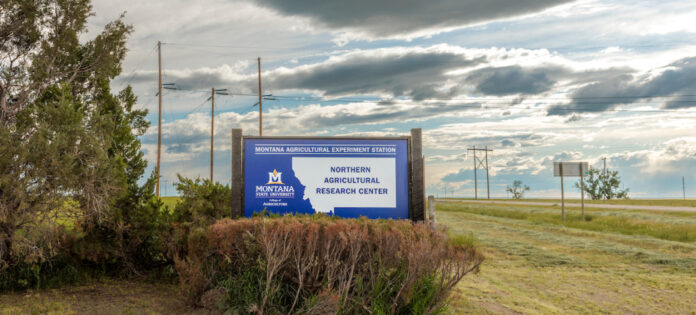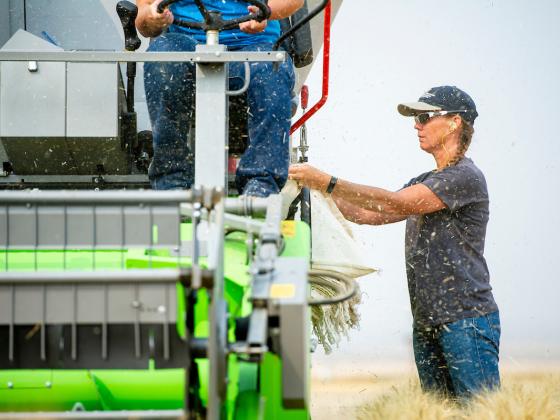BOZEMAN – Of Montana State University’s seven agricultural research centers, the facility in Havre, the Northern Agricultural Research Center, is the largest by several metrics: acreage, staff and cows.
When fully staffed, the 7,000-acre center is home to as many as 400 mother cows and about two dozen employees, including four tenure-track faculty and a research scientist. Research programs include two focused on animal science and two focused on crop production. A cropping systems agronomist is charged with intensifying the current wheat, oilseed and pulse systems currently being used in the Golden Triangle area of Montana. NARC is also expanding to include a fifth scientist tasked with conducting research and developing outreach programming focusing on precision agriculture.
Superintendent Darrin Boss, who also serves as the College of Agriculture’s associate dean for research, said the people are what make the center so productive in both research and outreach.
“The support staff at NARC are the most important part, not often seen when the research results are disseminated,” said Boss. “They enable our faculty, graduate students and research support staff to flourish and conduct transformational research that is applicable to our producers.”
Part of the facility, Thackeray Ranch, is a fully operational cattle ranch that studies everything from cattle nutrition and forage quality to precision technology that can tailor feeding and supplementation. Variety trial both on- and off-station test new and old varieties of crops like wheat, barley, pulse crops and oilseeds for yield, quality and resistance to pests and disease.
Sam Wyffels, an assistant professor in the Department of Animal and Range Sciences, earned his Ph.D. at MSU and spent much of that time as a research assistant at NARC. He still conducts research both in Havre and on the MSU campus in Bozeman. Now in his fifth year as a member of the faculty, he credits the team and facilities at NARC for the productive start to his research, which studies grazing forage for cattle.
“A lot of our lab’s research program is looking at ways of reducing reliance on harvested feeds,” said Wyffels. “Feeding cattle is one of the biggest costs for producers. What kind of management options are there to reduce some of that reliance? The research centers have producer-led advisory councils, so when they meet, there’s always questions of what their needs are. What I’ve always loved about Havre is that it’s applied research that has direct impacts on producers, and even includes active producer involvement.”
Wyffels’ work examines grazing season length and cattle nutrition, with exploration into how forage can be supplemented by other dietary elements to ensure that herds receive all the nutrients they need. MSU’s research centers, and NARC specifically, allow faculty to delve into the questions that are most important to farmers and ranchers within Montana, allowing for further precision through regional specificity, he said.
Havre, for example, is lower in elevation than many areas of the state, with a relatively arid climate and cold winters. Having a research center along the northern tier of the state allows for focused information that producers can implement directly on their operations.
“They’re always asking for input. People make suggestions or ask questions, and they always listen,” said Max Cederberg, a third-generation grain farmer who served on the NARC advisory board for a decade. “They’ve done projects on things like fertilizer rates so they can show producers what to do and what not to do, and it’s nice that they do that because then you don’t have to go out and experiment on your own.”
Cederberg grows spring and winter wheat along with durum on his farm near Turner, about an hour northeast of Havre. In addition to commercial growing, his land has hosted off-station plots overseen by Peggy Lamb, a research scientist at NARC, for more than 40 years. Through such partnerships with producers, each participating farm becomes its miniature research center, providing even more granular information into the performance of crop varieties. On average, Lamb’s on- and off-station variety testing program manages and collects data on over 5,000 plots yearly, benefiting farmers, plant breeders, agricultural commodity groups and the Montana economy.
“It’s nice to have [NARC], because we get to look at all the new grain varieties that come from MSU and how they work in our area,” said Cederberg. “We can compare them to Havre, which is a bit different.”
Cederberg hosts tours of the research plot on his land each year and also attends the NARC annual summer field day. The series of events, held at each of the seven research centers, invites producers and members of the public to share a meal, tour facilities, learn about ongoing projects and offer questions or feedback. The eight-stop field day series this summer will begin with the Havre event on Thursday, June 20 at 3 p.m.
And while the field days are always worthwhile to attend, Cederberg said the faculty and staff at NARC have made local producers feel welcome to call or visit with questions or feedback at any time, not just one day every summer.
“Their goal is just to make farmers more efficient and better farmers, and I think they do the job,” he said. “And they’re always so open. When you come through the door, you’re No. 1. They’ll drop everything to answer your questions and help you out. There’s always advice or help at the other end of a phone call.”
Helping to make operations more efficient has indeed become a focal point of programming at the center. NARC has been conducting field research since 1914 but has modernized with the times. Recently, Boss and colleagues conducted an eight-year study integrating cover crops into a wheat-based cropping system that examined both yield and soil health, as well as the impacts of cattle grazing those alternative forage sources.
As agricultural producers cope with increases in production costs, they have to find alternatives to reduce inputs, regardless of whether they produce grains or livestock, said Boss. He noted that this research has made a significant impact across Montana, as producers look to use alternative forages and allow the cattle to graze longer into the fall and winter months.
In response to both producer demand and the College of Agriculture’s prioritization of a new precision agriculture program, a new layer of research is evaluating cutting-edge agricultural technologies with a two-pronged goal: to potentially implement them in on-station research and to provide guidance and information for producers who may be interested in integrating them.
GrowSafe and C-Lock Smartfeed systems are two such precision data collection technologies that can collect real-time information on health in cattle to assist in making recommendations for adjustments to supplements or feed.
“There’s a lot of stuff out there from a research standpoint that can really help us capture animal behavior or whatever your research metrics are at a really fine scale that we didn’t have before,” Wyffels said. “But a lot of these products are also available commercially for producers, which means that one of the nice things we can offer is a test bed. We can offer some input on what these technologies are and how to integrate them, help direct some decision making.”
Wyffels echoed Cederberg’s appreciation for collaboration across the research centers and local agricultural communities. From the time he arrived in Havre to begin his research in 2019, Wyffels said the connections and communication of needs, ideas and questions has led to better, more productive research, along with strong relationships that extend across the state.
“I think what’s unique about NARC is that you come up with an idea, you pitch that idea and other folks have things they can add to it,” said Wyffels. “You come up with a more collective, larger project than if I stayed within my specific lane without bringing anyone else in. I think it’s the recipe for success.”
For Boss, who has worked at the research center for 30 years and has been the superintendent for 14, now is a particularly exciting time at NARC. Two new faculty members, Hannah Speer and Ricardo Pinto, are taking research in new directions, which Boss said is exactly the mission of the research centers. Speer, who joined the faculty in January, is developing a research program focusing on beef cattle range nutrition, while Pinto, who will begin later this year, will use satellite data to interpret severity of wheat stem sawfly outbreaks, allowing producers to have one more tool in the toolbox.
“During the interview process, producers who aided in the search resonated with both Drs. Speer and Pinto. That kind of trust, engagement and connection in a very short period of time is what it is really all about when you work at a research center in Montana,” said Boss. “Generating solid data that helps the producers of today be successful and pass their operations on to the next generations of Montana producers is paramount across our state.”





